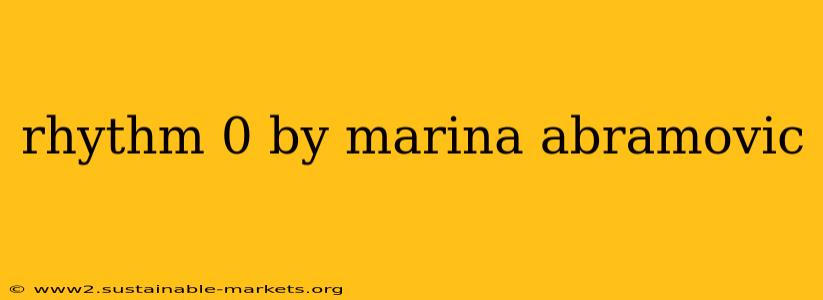Marina Abramović's Rhythm 0 (1974) remains a chilling and captivating piece of performance art, continuing to provoke discussion and analysis decades after its initial presentation. This exploration delves into the performance's context, execution, and lasting impact, examining its implications for the relationship between artist, audience, and the boundaries of art itself.
The Setup: A Tableau of Power and Vulnerability
Rhythm 0 wasn't simply a performance; it was a meticulously designed social experiment. Abramović presented herself as a living canvas, passively standing for six hours while audience members were invited to use 72 objects arranged on a table to interact with her. These objects ranged from harmless items like flowers and feathers to potentially dangerous tools including knives, scissors, a gun, and a single bullet. The artist remained silent and immobile, surrendering her agency completely to the unpredictable whims of the participants.
This stark setup immediately established a power dynamic. Abramović's vulnerability was laid bare, her physical and emotional well-being entirely in the hands of the audience. This deliberate relinquishment of control created a space where the audience's inherent impulses – whether benevolent or destructive – were starkly revealed. The seemingly simple act of passive presence became a profound exploration of human nature and the potential for both extreme kindness and unthinkable violence.
The Performance: A Descent into Chaos
The initial hours of Rhythm 0 saw relatively restrained interactions. Participants approached cautiously, using the less dangerous objects to adorn Abramović's body. However, as time progressed and the atmosphere intensified, the interactions became increasingly aggressive and threatening.
The escalating tension underscores the fragility of social order and the thin line between civility and savagery. The audience, initially passive observers, transformed into active participants, reflecting humanity’s capacity for both empathy and cruelty. The performance became a microcosm of society, showcasing its inherent contradictions and unpredictable nature.
The Aftermath: Reflections on Power and Agency
Abramović's experience was deeply personal and transformative. While the exact details of the interactions remain somewhat obscured, accounts suggest that the situation became genuinely dangerous. Participants threatened and even physically harmed her, highlighting the dangers of unchecked power and the fragility of trust.
The artist's decision to halt the performance only after the allotted six hours speaks volumes about her commitment to the artistic concept. This commitment, coupled with the audience's actions, solidified Rhythm 0 as a profound exploration of human behavior, power dynamics, and the inherent risks associated with relinquishing control.
The Legacy: A Continuing Conversation
Rhythm 0 continues to resonate with contemporary audiences because it tackles timeless themes of power, agency, and human interaction. Its legacy extends beyond the art world, sparking conversations in fields like sociology and psychology. The performance serves as a stark reminder of the potential for both good and evil within humanity, and the importance of conscious engagement with the social dynamics that shape our interactions.
The impact of Rhythm 0 is undeniable. Its legacy lies not only in its artistic merit but also in its ability to prompt a critical self-reflection on our collective potential for both remarkable acts of kindness and shocking displays of violence. The performance continues to serve as a potent symbol of the complex and often unpredictable nature of human interaction.

